 Along with the cover letter was an information letter on the 6220th that advises me of the duties, the living conditions “the squadron is operating under field conditions with 1/3rd of the men being housed in modern open-bay dormitories and the balance in screened tents.” He goes on to cover banking, laundry, and money exchange along with church services. He really goes into detail about the recreational facilities. He talks about the “balls”-hand, soft, hard, volley, basket and bowling. Some nice suggestions about French and Vietnamese language classes in Saigon, great camera prospects along with sightseeing. He ends with “There is no dearth of bars and good restaurants”. Now things are looking up! Plenty of bars and restaurants. He closes the letter stating:
Along with the cover letter was an information letter on the 6220th that advises me of the duties, the living conditions “the squadron is operating under field conditions with 1/3rd of the men being housed in modern open-bay dormitories and the balance in screened tents.” He goes on to cover banking, laundry, and money exchange along with church services. He really goes into detail about the recreational facilities. He talks about the “balls”-hand, soft, hard, volley, basket and bowling. Some nice suggestions about French and Vietnamese language classes in Saigon, great camera prospects along with sightseeing. He ends with “There is no dearth of bars and good restaurants”. Now things are looking up! Plenty of bars and restaurants. He closes the letter stating:
After a short visit home, I packed my bags and headed for Travis AFB. I was told that I did not need to report in for 3 more weeks, etc. I asked if I could just catch a flight to Clark, that I would rather spend part of December in the Philippines than in Upstate New York. He agreed.
On January 10, 1963 I landed at Tan Son Nhut Air Base, Republic of Vietnam, turned in my diplomatic passport and looked for a place to sleep. One nice thing about being an air cop, you just have to look out the terminal door to spot one of the blue trucks with the white stripe to take you home. The barracks was fairly empty, with most men on duty, the rest in Saigon, going to Saigon, or staggering back from Saigon. An Airman greeted me like his long lost brother.
At first I thought it was my great personality, but only to find out I was HIS replacement. Now that I’m in country he plans on being out of country within a day or 2. We talked for a bit, went out to a “stick shack” for a beer where he gave me some important advise. One; get to know the clerk in headquarters who cut the orders, and Two, get to know the person who handles all travel arrangements for departing troops, someday you’ll need them.
The next morning I reported in to the group and met MSgt Wilbur J. Emma, NCOIC Security & Law Enforcement. We had no officers assigned to this group; it was run by a bunch of NCO’s who earned their strips in either WW2 or Korea and a great lot, the whole bunch of them.
The cop shop was made up of two basic groups, those who were there TDY from Tachikawa AB Japan. (Arriving late December till about June 63 and slept in tents) and those PCS (they lived in barracks).
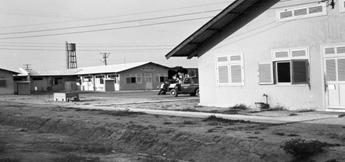
AIR POLICE BARRACKS
The TDY 10 man team was Air Policeman Bob Anisko, Bob Cruz, Taylor, Hill, and Harvey Clark along with Staff Sergeants Paul Cole & Jack Powers, both were armorers from stateside and were evaluating the AR 15 for Air Force use. Although they were assigned to the Cops, we would not see the AR 15 for duty use for several months.
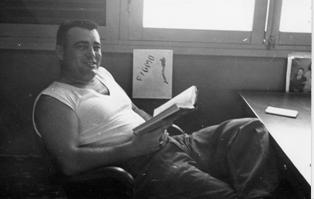
SSgt JACK POWERS (ARMORER) ON DUTY
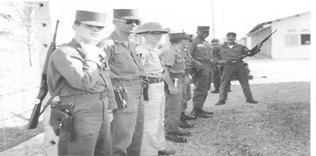
DAYSHIFT GUARD MOUNT
Our Guardmount was normally about 7-9 people per shift. A supervising SSgt, a desk Sgt (an Airman), 1 law enforcement patrolman, 1 gate guard at the entry of the AF Cantonment area, 1 guard at the Security Service Communications trailer, 1 inside the Air Operations Center Bldg, 1 ramp flight line guard to watch over a small fleet of C123 aircraft with big spray rigs (with yellow liquid, that they kept calling orange) and finally the “ammo dump”, when manpower would permit a SAT team of 2 which would handle toilet breaks and coffee runs.
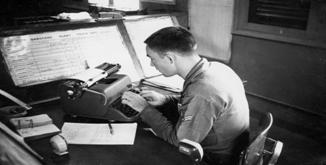
DESK SGT JOHN MARTIN
To the best of my memory some of the AP Staff Sergeants where: SSgts Lort & Graham, Tony Keffer, Oscar Phillips, and Lloyd Collins.
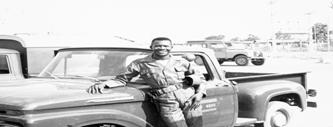
L.C. BANKS
The Airmen were, LC Banks, Grant Nelson (pass & ID) Tony Palermo, Charley Landry, Fred Harper, John Martin, Bob Schropshire, Cleveland Stokes, Paul Larochelle, Al Linder, Groves, Skyeks, along with “Ski” & “Speedy”.
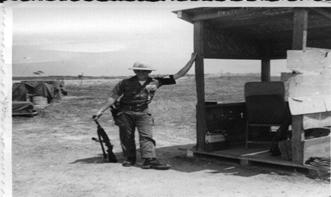
AMMO DUMP DUTY
After pulling the normal share of grunt posts “to learn the ropes” I started working the Law Enforcement patrol, normally by my self, then joint patrol with MP’s. The Army was starting a build up of manpower on TSN, so the joint patrol was a good effort in cross branch cooperation.
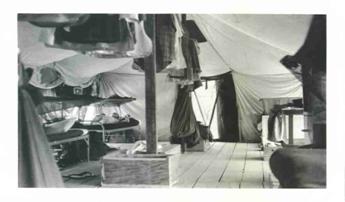
HOME TO THE TDY TROOPS
Life in those days, although primitive was good. The mess hall, BX and base theatre were all in an old French Air Force cement hanger. The Air Force had to drag a bunch of “old” senior sergeants out of Mess Hall Management and put them back to cooking. This was something they hadn’t done in years since the AF contracts out most food service with the NCO as the Manager. This mess hall served all ranks with the same metal trays I hadn’t seen since basic training. In back of the serving line was a bunch of 55-gallon drums cut in half for grilling. We ate a lot of grilled chicken, steak and a few items I was never sure of, but if they could grill it, we would eat it. The food was basic, but very good. This would last for about 6 months when the new mess hall would be completed with screened windows and real kitchen equipment, along with mess check and dress regulations.
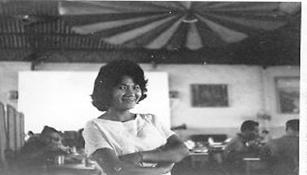
OLD MESS HALL
After chow you could walk to the corner of the hanger to a 10 by 10 room that was the BX. It carried only the very basics like cigarettes, booze, soap and toothpaste along with cold American beer. You could by a couple of cans, go back to your dinner table and watch the movie. The evening finished between 8: 30 and nine o’clock. After that, a few beers at the stick shacks and off to bed.
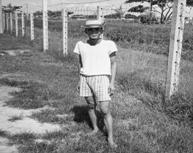
HOUSE BOY “PHO”
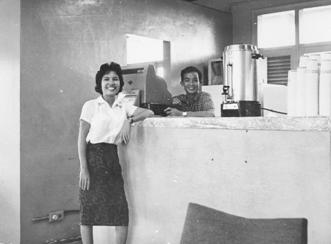
AIRMAN’S CLUB SNACK BAR
Between January and July of 63’ life and duty was continuing to be good, a bit laid back but since we were the ones chosen for “maturity, dedication and stability” not much happened. As construction moved along within the cantonment area we will have a new mess hall, an “airman’s” club, library, and Air Police Operations. The airman’s club was open to anyone since we didn’t have an officers or NCO club yet. The club had a snack bar, a bar, and a few slot machines. Not much else there, but after the library and flight operations, it was the only other air-conditioned building and that was a relief.
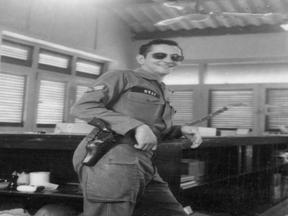
PALERMO IN PASS & ID
The Air Police Operations building was shared with Pass & ID on one half, and Operations on the other. The Operations area consisted of one jail cell 8’ x 8’ (rarely used), the Desk sergeant’s desk, and the small armory area next to the Desk sergeant. The NCOIC had a desk in Pass & ID. On your days off you had Saigon, or Vung Tao an old French resort on the coast. It was a great place if you could get there and back safely. A few of us choose to go flying.
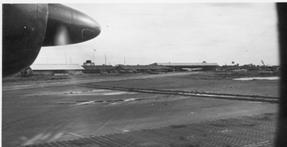
The Army had Caribou aircraft that left TSN daily for runs to remote areas to supply the Green Berets and other American civilian advisors (AKA: CIA) in the field. These runs could get hairy at times, so you went well armed, but you got to see a lot of the county.
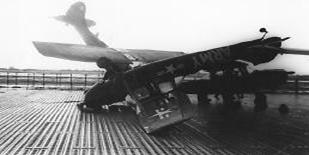
SPRING TYPHOON AT TSN
During May, demonstrations started in Saigon against the current government. President Diem was put in place by President Eisenhower and kept in power by President Kennedy. The Diem government was corrupt and day-to-day life ruled by the President’s Sister (AKA Dragon Lady) and Brother-in-law Ngo Dinh Nhu. Nhu headed their “secret police” and the Sister controlled the “moral laws” enforcement. Since they held power with the backing of the US Government, these demonstrations started to be directed toward US personnel.
Following the demonstrations in May came the monk burnings in June. Now things were getting hairy! Without any notice, a monk would walk out into the middle of a major intersection, pour gas over himself and light up. Most of these took place in front of the National Assembly, at the intersections of the Grand & Caravelle hotels, both with a large American clientele. The smell was enough to spoil a quiet afternoon with a drink on the patio of the Grand Hotel because you had about 2 minutes to get the hell out of there before the demonstration began.
This group did more to support the cause of the VC, than the VC could do for themselves. Life in the Pearl of the Orient was going to hell fast!
In July of 1963 we were the first group of Air Force personnel to draw combat pay for service in Vietnam. We had tripled the fleet of C-123’s now called Operation Ranch Hand.
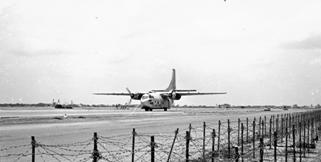
The TDY group of men had returned back to their bases in Japan and the States, and now replaced with PCS personnel. “The times they are a changing”. We were still lean on manpower but the new hands on board helped make a difference. Our 2 man SAT team now moved up to 4 men now armed with the new AR 15’s. No more toilet breaks or coffee runs. The SAT teams worked generally one or 2 shifts from sun down to sun up spending most of the time patrolling the flight line areas and base perimeters. We did not have dog patrols although we heard rumors that some of the other remote AF posts did.
On 31 October 1963 “unnamed” American civilian advisors from MAAG briefed us that the US government was pulling its support from President Diem. That within the next couple of days the crap was going to hit the fan, and it was recommended that all Americans assigned to TSN stay at TSN.
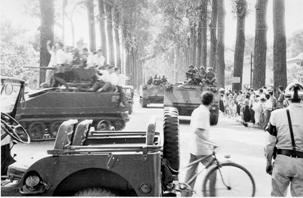
OUTSIDE TSN AIRPORT MAIN TERMINAL
Several Air Force types that lived and worked in Saigon moved on base for their safety. We set up 4 SAT teams and positioned them in discreet locations, just in case. We were reminded that we (Americans) were “guests” of the VN Air Force at their
base. I positioned my team near the Main Gate in case our VN QC brothers had a problem that we would be able to assist. The next morning the Coup started. It lasted most of the day in and around the Presidential Palace never affecting us directly at TSN. A lot of damage occurred to government buildings from tank fire, plus several VN civilian deaths. The President and Nhu were captured early the next morning and immediately shot and buried in 2 spare graves that just happened to be ready. The US Embassy announces later that day that the 2 had committed suicide. Now at this point I’m a fresh A1C who just completed a course on Criminal Investigations could not understand how the two of them shot themselves in the back of the head. But I knew the Embassy was always right.
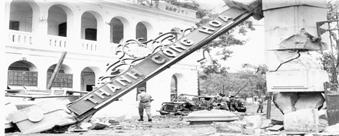
ATTACK ON THE PRESIDENTAL PALACE
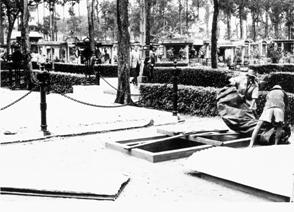
GRAVES READY ON DAY OF COUP
In celebration the VN Air Force reopened their O Club and invited all Americans based at TSN to join them in festivities with food, drink and dancing. This was a big deal due to the fact that dancing was illegal under the old “morals” law.
Life was now returning to normal. The coup aftermath had quieted down in Saigon but building up in the Corps region with VC taking larger daring raids. We were now hearing mortar fire nightly most if it aimed at the villages surrounding TSN. A few strays came close but never hit the base.
Thanksgiving of “63 had dinner in the new mess hall with tablecloths and flowers on the table. Civilization had returned.
December brought the normal “congratulations” call from the Group Commander advising me that I have been “selected” for reenlistment. Just spend a few extra months here in the Pearl of the Orient and I could have base of my choice, a guaranteed stripe etc. I think he would have been willing to give me his first born to say yes. That evening after a great steak dinner with all the trimmings, a bottle of French wine on the floating restaurant in Saigon, I flipped a coin. Stay in or get out.
In January 1964 I found myself winging my way back to Travis for an early out.
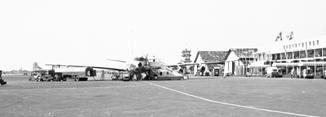
FLIGHT HOME
College, time with the Los Angeles County Sheriffs Department, on to airline and aviation management and life went on never looking back. Except for the occasional calls from the Air Force Reserve about fun filled weekends I put TSN behind me and did not bring it up until 1995 when I received an e mail from Bob Anisko telling me about VSPA, the rest they say is history.
CONSTUCTION AT TSN JANUARY 1964
Making room for those who will follow:
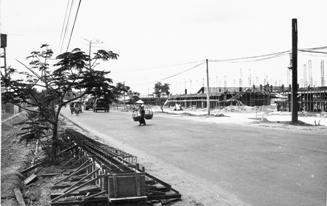
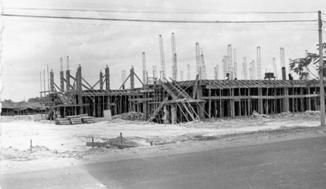
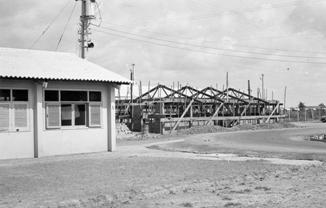
A special thanks to Bob Anisko for his help with the memories and photos.